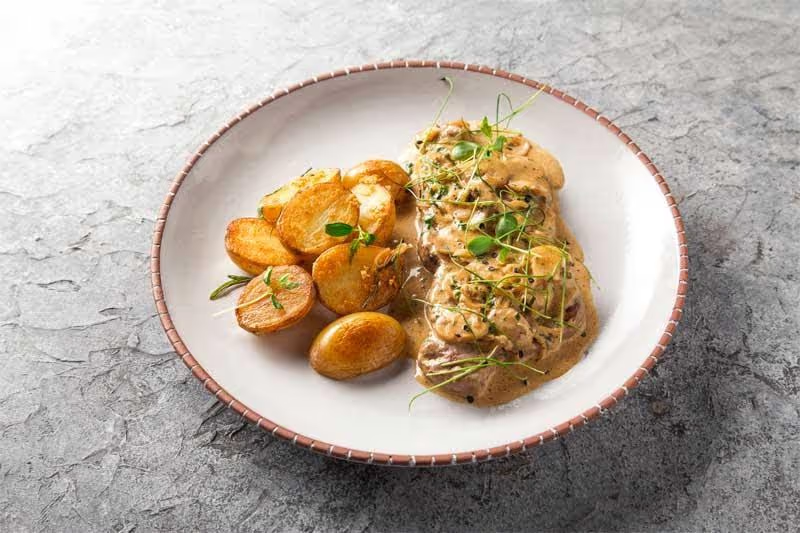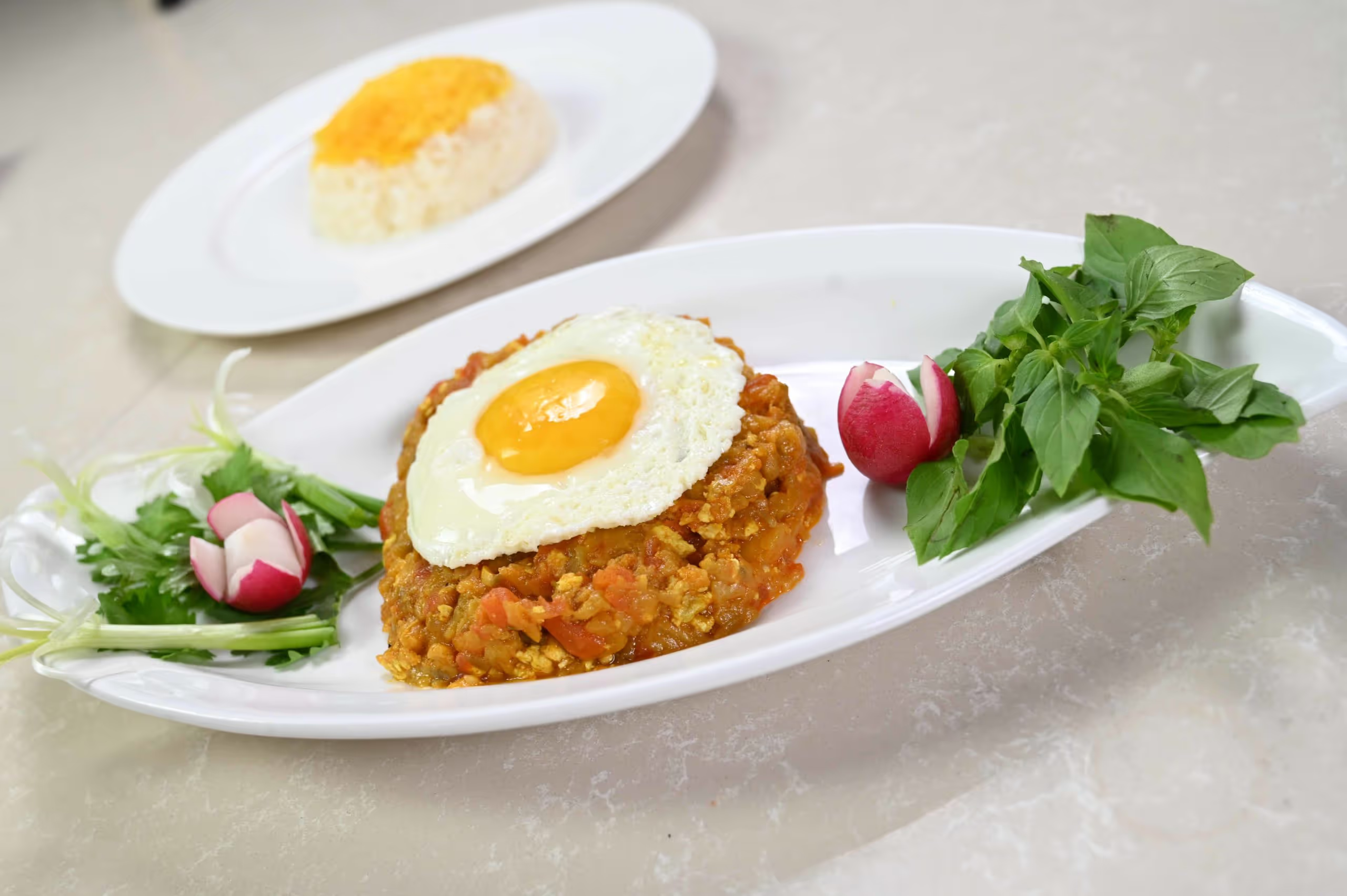The tenderized succulent steak is paired well with the rich creamy mushroom sauce and the chopped parsley adds a hint of freshness to the dish, which is served with crispy fluffy rosemary roast potatoes.
Beef is the culinary term used for meat from Bovines (Cattle). The word beef originally adapted from the Latin word “bos” meaning ox, then translated to “boef” in old French and finally made to its current name, “beef” in middle English.
Beef ranks third as the most popular meat consumed by people and accounts for 25% of meat production in the world. The variety of beef products range from ground beef, all the way up to steaks, from bovines grown in the modern, conventional and as well as organic ways.
Organic beef is from cattle that are only fed organic grain and grasses grown without the use of artificial chemicals, fertilizer or pesticide and the cattle are reared without the use of artificial chemicals such as antibiotics and growth increasing hormones. Organic beef is very popular among those who are health conscious.
English cuts of Lamb have evolved through the centuries and reflect the change in cooking methods and taste in English homes.
Apart from this, processed beef is also commonly available in the supermarket made from beef that is preserved to increase its shelf life by the process of curing, smoking, salting or other added preservatives. The extensive use of chemicals here, generally render the meat, not good for health and increases the risk of cancer and other diseases.
When buying meat, it is always good to ask a professional butcher to provide you with the right cut of meat and personalized requests could also be made to portion down the meat to the required size in line with your recipe, for added convenience.Here are some popular cuts of Beef...
1. Fillet Mignon
Known as tenderloin steak; it is taken from a tenderloin (a long strip of steer’s most supple meat).
2. Flank
Known as jiffy steak; this long flat cut from the belly muscle has a distinctive vertical grain and can be a bit chewy. Always sliced thin against the grain, because it tends to get stringy when overcooked.
3. Flat Iron
Known as top blade steak; this small shoulder cut from the chunk region. It is tender and cooks quickly, and one of the most inexpensive type of steak.
4. New York Strip
Known as shell steak, top loin steak and Kansas city strip. Cut from the top of the short loin, New York strip, a longtime steak house favorite, it is renowned for its robust flavor and somewhat dense texture.
5. Porterhouse
Known as Tuscan steak. Cut from the short loin; they are just behind the steer’s rib section, the porterhouse is a combination of two prized cuts of beef: the rich-tasting New York strip and the buttery-soft tenderloin.
6. Sirloin
Known as top sirloin steak and sirloin butt steak. Sirloin comes from the area between the short loin and the round. It is of a higher quality than the bottom sirloin; it comes from right below the tenderloin and has a similar texture to New York strips.
7. T-Bone
Named for its distinctive T-shaped bone, this high quality steak is much like a porterhouse. The difference is that it is cut from the front end of the short loin, and hence contains less tenderloin meat.
8. Brisket
One of the tougher, leaner cuts (it comes from the breast, just behind the front leg or fore shank). Brisket is still flavorful with long, slow cooking. The two cuts found in the supermarket are the leaner flat or first cut and the thicker, more flavorful point cut, which includes a layer of fat.
9. Chuck Roast
Large, square shoulder portion of the steer is coarse grained and tends to have lots of connective tissue running through it. It is tough yet flavorful, making it an inexpensive choice for stews and pot roast.
10. Ground Beef
For tender, juicy burgers and meat loaf choose ground chuck. Ground meat is made from lean cutswhich tend to dry out and are therefore best for chili and meat sauces. Look for meat that’s bright red (browning indicates that the meat is not fresh).
11. Short Ribs
A rectangular, block like pieces that is 2 to 3 inches long, and comes from the loin, chuck or mid-rib area. Thick layers of meat and fat give the ribs a rich taste, but they can be tough, so they are not suitable for grilling. Instead, they are good for long, slow covered cooking.
Meat Recipe of the Day - Steak Diane

About Steak Diane
Fables state that “Diana” was the Roman goddess of ‘wild animals and the hunt’ and several artistic depictions depicted her accompanied by a deer. Appropriately, in the 19th century, sauces dedicated to her were made under the name “a la Diane” and were accompanied by venison meat. The origin of how Steak Diane came into being is actually unknown but New York has been heavily linked as its birthplace.
Steak Diane is similar to “Steak au poivre”; both are made thin by either pounding or cutting the meat to cook rapidly. Tender Fillet mignon is pounded thin to a half-inch thickness, sautéed and flambéed, to caramelize the sauce and intensify the flavors, thus, taking it to another dimension.
Generally ‘Sauce a la Diane’ accompanies this steak, which is traditionally made of truffles, cream, and a good amount of black pepper.
This Dish
The tenderized succulent steak is paired well with the rich creamy mushroom sauce and the chopped parsley adds a hint of freshness to the dish, which is served with crispy fluffy rosemary roast potatoes.
Recipe Card (to serve 4 pax)
Method of Cooking
- In a medium saucepan, parboil the potatoes in boiling salted water for 5 minutes or until just tender. Drain the potatoes and set aside.
- Place the steaks between two sheets of cling film and using a rolling pin, roll out the steaks to flatten (cut off the rind of fat optional). Season the steaks on both sides with salt & black pepper.
- In a medium sauté pan heat a little olive oil, then sauté the steaks for 1 minute on both sides to color, then remove from the pan and set aside to rest.
- In the same pan on high heat add a little more oil if necessary. Add the shallots (season with salt & black pepper) sweat for a minute then add mushrooms, garlic and butter, and stir.
- Add the Worcestershire sauce and mustard and cook for 1-2 minutes. Pour in the chicken stock and let it reduce for a few minutes.
- Pour in the cream and add the steaks and any resting juices back into the pan. Cook the steaks through for 2-3 minutes. Add the chopped parsley and stir.
- Slice the parboiled potatoes in halves.
- In a separate sauté pan, heat a little oil and place the potatoes sliced side on the pan and cook for a minute. Season with salt & black pepper and add the rosemary and crushed garlic and sauté for 1 minute.
- Toss the potatoes, add a knob of butter and sauté for a further 1-2 minutes until golden and cooked through.
- Serve steak and rosemary potatoes hot.







.avif)


.avif)
.avif)